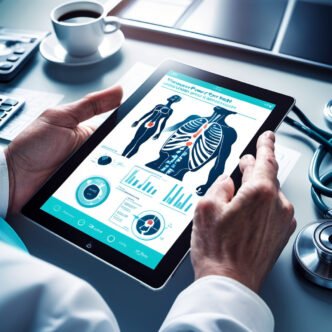As of late, wellbeing tech has arisen as quite possibly one of the most extraordinary areas in the worldwide economy. By utilizing state-of-the-art innovations like man-made reasoning (simulated intelligence), the Web of Things (IoT), and high-level information examination, wellbeing tech is reclassifying the way that medical care is conveyed, made due, and experienced. This article investigates the different features of wellbeing tech, its effect on current medical care, and what the future could hold.
Understanding Health Tech
Wellbeing tech, short for medical services innovation, alludes to the use of innovation and advancement to further develop well-being results, upgrade patient consideration, and smooth out medical care frameworks. From wearable wellness trackers to telemedicine stages, well-being tech envelops a great many instruments and arrangements pointed toward making medical care more open, productive, and customized.
Key Drivers of Health Tech Growth
A few variables have added to the fast development of wellbeing tech:
- Maturing Populace: As populaces age, the interest in medical care administrations is expanding. Wellbeing tech gives answers for overseeing persistent sicknesses, working on senior consideration, and backing maturing setup.
- Rising Medical sServicesExpenses: Innovation-driven efficiencies can assist with diminishing expenses by advancing cycles, lessening blunders, and empowering deterrent consideration.
- Shopper Assumptions: Patients currently expect medical care encounters like those in different businesses — helpful, customized, and innovation-empowered.
- Technological Advancements: The proliferation of AI, cloud computing, and wearable devices has created new opportunities for innovation in healthcare.
- Worldwide Wellbeing Difficulties: Occasions like the Coronavirus pandemic have sped up the reception of computerized wellbeing arrangements, featuring the requirement for strong and versatile medical services frameworks.
Innovations in Health Tech
- Telemedicine and Virtual Consideration: Telemedicine has changed admittance to medical care by empowering distant meetings. Patients can associate with medical care suppliers using video calls, diminishing the requirement for in-person visits. This is especially advantageous for those in the country or underserved regions.
- Wearable Technology: Devices such as smartwatches and fitness trackers monitor vital signs like heart rate, sleep patterns, and physical activity. These gadgets empower individuals to take control of their health and provide valuable data for healthcare providers.
- Man-made brainpower: simulated intelligence calculations are being utilized for diagnostics, treatment arranging, and medication disclosure. For example, computer-based intelligence imaging instruments can recognize conditions like a disease at the beginning phase, further developing results.
- Electronic Wellbeing Records (EHRs): Advanced well-being records smooth out understanding information the executives, empowering consistent data dividing between suppliers and further developing consideration coordination.
- Mechanical technology in Medical services: Robots are aiding medical procedures, restoration, and patient consideration. Mechanical helped a medical procedure take into consideration more noteworthy accuracy, more limited recuperation times, and further developed results.
- Customized Medication: Advances in genomics and biotechnology have made ready for medicines custom-made to a person’s hereditary cosmetics. This approach is especially encouraging in regions like oncology and uncommon sicknesses.
Benefits of Health Tech
- Worked on Quiet Results: Innovations like artificial intelligence and prescient investigation empower early analysis and intercession, prompting better well-being results.
- Upgraded Openness: Telemedicine and portable well-being applications make medical care benefits more available, particularly for those in distant regions.
- Cost Productivity: Robotization and information-driven experiences assist with diminishing waste, forestalling blunders, and upgrading asset use.
- Enabled Patients: Wearable gadgets and versatile applications urge people to take part in their well-being on the board effectively.
Challenges in Health Tech Adoption
- Information Protection and Security: With the rising digitization of well-being information, worries around network safety and patient security have developed. It is basic to Guarantee powerful insurance.
- Administrative Obstacles: Exploring complex administrative conditions can be trying for the well-being of tech organizations. Consistent with principles like HIPAA in the U.S. or then again GDPR in Europe is fundamental.
- Interoperability Issues: An absence of normalization frequently hampers the consistent trade of information across various frameworks and stages.
- Advanced Gap: Not all populaces have equivalent admittance to wellbeing tech arrangements, featuring the need to address differences in innovation reception.
- Moral Worries: The utilization of simulated intelligence and other trend-setting innovations brings up moral issues, like the algorithmic inclination and the potential for abuse.
The Future of Health Tech
The fate of wellbeing tech looks encouraging, with a few patterns ready to shape the business:
- Extension of artificial intelligence Applications: man-made intelligence will assume a bigger part in regions like psychological well-being, drug improvement, and persistent sickness of the executives.
- Reconciliation of IoT: Associated gadgets will empower continuous well-being checking, cultivating a proactive way to deal with medical services.
- Headways in Genomics: Leap forwards in hereditary examination will prompt more exact and powerful medicines.
- Development of Computerized Therapeutics: Programming-based intercessions, for example, applications for overseeing diabetes or psychological well-being, will get momentum.
- Expanded Joint effort: Organizations between tech organizations, medical care suppliers, and legislatures will drive advancement and adaptability.
Conclusion
Wellbeing tech is changing the medical care scene, offering phenomenal chances to further develop well-being results, improve patient encounters, and diminish costs. While challenges remain, the proceeded with intermingling of innovation and medical services holds the commitment to a better, more impartial future. As we explore this thrilling period, joint effort, development, and an emphasis on moral practices will be critical to opening the maximum capacity of well-being tech.













